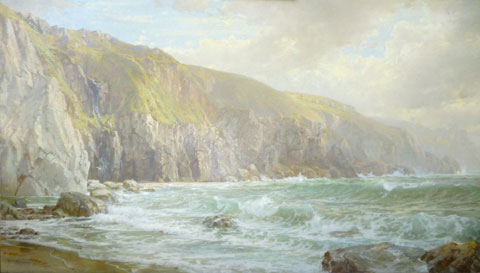In celebration of a gift of 110 William Trost Richards watercolors, the Pennsylvania Academy of the Fine Arts presented the gift in its entirety in a focus exhibition September 29 - December 30, 2012. The watercolors were shown in conjunction with a selection of Richards oil paintings from both the permanent collection and select private collections. These jewel-like watercolor landscapes by the American Pre-Raphaelite artist delighted visitors with their intimate scale and technical mastery of the watercolor medium.

Most Westerly Rocks of Land's End, Cornwall, 1879, William Trost Richards. (Image courtesy PAFA)
Curator: Anna Marley, Curator of Historical American Art

William Trost Richards, An Essay at Twilight, Newport, 1877, Watercolor on paper, 3 5/16 x 5 inches, Promised gift of Dorrance H. Hamilton in memory of Samuel M. V. Hamilton, 22.5.2008
From Chestnut Hill Local:
The exhibit features popular Chestnut Hill retreats such as
“The Forest” (1868), a large and detailed painting of Devil’s Pool; and
“The Wissahickon” (1872), a stunning painting of the picturesque creek winding between wooded banks through Fairmount Park.
“The Forest” was lent to PAFA by the Palmer Museum of Art of Penn State University, and “The Wissahickon” is courtesy of Drexel University College of Medicine.
Whitney, a hugely successful businessman whose fortune came from the manufacturing of wheels for railroad cars, acquired at least one oil painting from Richards annually from the mid-1860s until 1872, and “The Forest” was one such purchase. It thus represents Whitney’s eager support of Richards’ career and was also likely Richards’ way of repaying Whitney for funding the artist’s travel abroad in the mid-1860s, further exemplifying the close working relationship between these men.
Hailed by critics as Richards’ Pre-Raphaelite “triumph,” “The Forest” captures the deeply shaded wooded dell known as the Devil’s Pool at the confluence of the Cresheim and Wissahickon Creeks in Chestnut Hill.
“The Wissahickon” depicts another scenic passage of Wissahickon Creek, here shown as a stream winding between tree-lined banks through a thickly wooded area of Fairmount Park. Set in Germantown, where the artist lived, and not far from Whitney’s summer residence in Chestnut Hill, this detailed rendering of a popular local retreat represents the close bond between these men both socially and geographically. The luminous canvas hangs in this exhibition with its earlier, low-lit counterpart, “The Forest,” just as it once was hung in Whitney’s own 19th-century Philadelphia art gallery.

William Trost Richards at the Newport Art Museum (June-September 2012)
...But by the 1870s, he had arrived at a blending of the two styles — dramatic and detailed depictions — and turned to primarily painting coasts and seas, especially the shores of Rhode Island after he began summering in Newport and environs in 1874. (The "Paradise" of the show's title refers to Middletown's Paradise Valley coast.)
Curator Nancy Whipple Grinnell includes representative samples of his seascapes — including Off the South Shore, his 1896 oil painting of a foggy, glowing green sea, and a 1899 painting of waves pounding a sandy beach at the foot of craggy
Guernsey Cliffs, Britain's Channel Islands.
They're quality paintings, but dry, photographic, crystalline.
The surprise comes via 110 postcard-sized watercolors that Richards sent in the 1870s and '80s to his friend and patron, George Whitney, a Philadelphia industrialist and art collector. They could be snapshots from Richards's travels — waves crashing against the rocky English coast, the sun setting between the cliffs of a winding Cornwall bay, a Newport marsh and pond, stormy skies, the streets of London, Stonehenge, bridges, cemeteries, the (now gone) Washington Elm on Cambridge Common in Massachusetts where (disputed) legend has it that George Washington first took command of the American army.
The reserve of his easel painting gives way in these little works to breathtaking scenes — all the more astonishing for what he's able to pack into 3-by-5 inches. The Daisy Field, Conanicut Island (1884) depicts a haystack and boulder amidst a rolling meadow speckled with flowers (Richards had a home perched on the Conanicut cliffs overlooking the sea). Ships dot the Atlantic in the distance; gulls hover on the breeze.
Read more: http://providence.thephoenix.com/arts/143041-william-trost-richards-at-the-newport-art-museum/#ixzz2WCTMsYuU (image, link added)
Catalogue:
Richards spent his time in Philadelphia, Pennsylvania, and Newport, Rhode Island. Both places served to inspire and advance his artwork, but it was in Philadelphia where Richards met the prominent collector George Whitney. Whitney first collected Richards’s works in the 1860s, and he soon became Richards’s friend and patron. Whitney funded several of Richards’s travels abroad and was an energetic advocate for Richards’s work. Richards painted the miniature watercolor landscapes (or coupons, as he referred to them) as gifts to Whitney. The paintings were often included in Richards’s correspondence with Whitney and depict the pastures and rocky coastlines of New England as well as scenes from the artist’s travels to Scotland, England, and Italy.
When Whitney died in 1885, his estate was sold, and his collection of Richards’s finest paintings—eighty-seven in all—were forcibly dispersed. Only Whitney’s collection of the small watercolors remained together. Remarkably, these paintings recently found their way back to Philadelphia to the Pennsylvania Academy of the Fine Arts (PAFA). Mirroring Richards’s life, these paintings also traveled between PAFA and the Newport Art Museum.
Marquand Books produced the 156-page catalogue, designed by Zach Hooker. The book’s tactile qualities—with embossed case stamping and an imprinted image on the cover—evoke the texture and intimate details of the paintings themselves. The entire collection of miniatures is featured in the catalogue. These watercolors, reproduced on a one-to-one scale, reveal the grace and sensibility of Richards’s artistic skill, and essays by Linda S. Ferber and Anna O. Marley illuminate the history of American landscape painting that surrounds these jewellike miniatures.
More images, link to the collection



